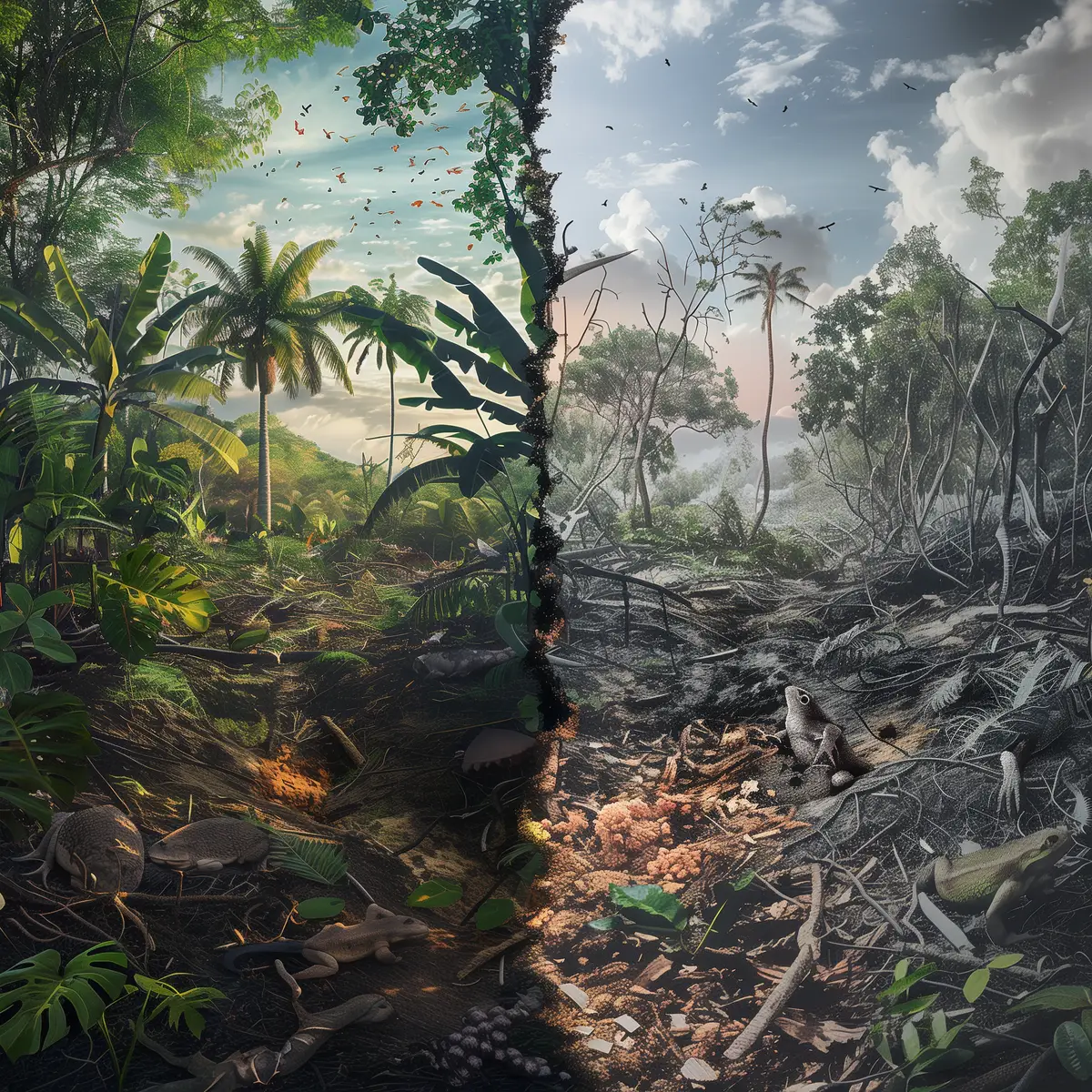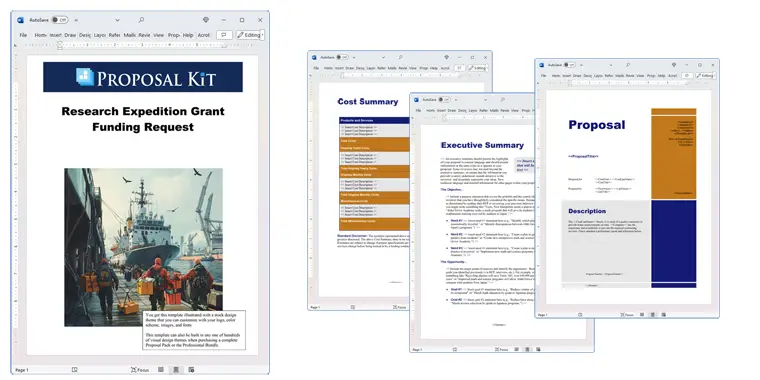How to write your Research Expedition Grant Funding Request
We include this 30 page layout with every Proposal Pack. If you want this template to have a different visual design theme than the one illustrated here, purchase any Proposal Pack design and create this template using the purchased design theme. This template is included in every Proposal Pack. If you get a Proposal Pack or the Professional, you can also make any variation of this template with different chapters to suit your needs.
We typically include more chapters in the templates than most people will need to give everyone more variety in the chapters they may need. You can trim down a long template by removing pages you do not need or combining multiple chapter topics into one page.
 DOWNLOADABLE, ONE-TIME COST, NO SUBSCRIPTION FEES
DOWNLOADABLE, ONE-TIME COST, NO SUBSCRIPTION FEESYou can also create countless variations of this document to suit your needs using the included library of 2200+ chapters if ordering a Proposal Pack or Professional.
 What Our Clients Say
What Our Clients SayThe Proposal Pack Wizard not only was very helpful in assisting me in writing grants, it is also excellent in helping to understand the structure of a good proposal. Prior to finding the Proposal Pack Wizard I spent hours writing and researching needed information, the Proposal Pack Wizard streamlines the process and produces a professional and quality proposal. Excellent selection in examples and a easy process."
Related Article
Related Video
Related Templates
- Extinction and Climate Change Study
- Climate Change Research Proposal
- Research Assistant Proposal
- Research Funding Request Proposal
- Non-profit Support Proposal
- Grant Funding Request Proposal
- Research Proposal (Long)
- Research Proposal (Short)
- International Research and Development Project Proposal
- Population Migration Due to Climate Change Study
- PhD Thesis Proposal
What's the best way to write your research expedition grant funding request?
The Proposal Kit template and software package is a proven solution that can simplify writing grant funding requests. This software also incorporates a line item quoting database system for cost summaries, quotes, estimates, budgets, and other financial topics, making it invaluable for scientific research expeditions.
Are you in a situation where you need to write such a proposal? The Proposal Kit is designed for you.
What Types of Projects Are Research Expedition Grant Funding Requests Written For?
Research grant funding requests are typically written for various scientific projects involving exploration and discovery. These proposals help secure funding for projects that might include:
- Marine biology studies exploring coral reef ecosystems
- Geological surveys of volcanic regions
- Archaeological expeditions in ancient ruins
- Climate change research in polar regions
- Biodiversity assessments in rainforests
- Oceanographic expeditions studying deep-sea creatures
- Astrobiology research in isolated environments
- Ornithological studies on migratory patterns
- Glaciology studies on ice sheets
- Botany research in remote mountain ranges
- Meteorological studies on storm patterns
- Ecological studies of endangered species
- Paleontological digs for dinosaur fossils
- Ethnographic research in indigenous communities
- Space research simulations
- Underwater archaeology of shipwrecks
- Anthropology studies of ancient cultures
- Seismological studies on earthquake activity
- Hydrothermal vent research
- Speleological studies in cave systems
Chapters this template is built with
Creating a research grant funding request requires customization to fit specific project needs; there is no one-size-fits-all premade template that covers every situation. Proposal Kit's software offers a starting point with templates that can be adjusted for any scenario. Here's a selection of chapter templates from Proposal Kit's extensive content library that can be used in such a proposal:
Cover Letter
The cover letter sets the stage for your proposal by introducing the purpose of the grant request and highlighting the significance of the expedition. This section should capture the attention of potential funders by emphasizing the unique topics of your research and how they align with their interests or goals.
Introduction
In the Introduction, provide a comprehensive overview of the project. This section should detail the expedition's goals and objectives, offering insights into the scientific questions being addressed. It sets the stage for detailed information that follows, explaining the expedition's significance.
Problem Statement
The Problem Statement outlines the specific challenges or gaps in knowledge your research aims to address. This chapter is crucial for justifying the need for funding, as it articulates the scientific problems your expedition will tackle and the potential impact of solving these issues.
Expected Results
In this section, describe the anticipated outcomes of the expedition. Emphasize the benefits of your research, such as advancing scientific understanding or contributing to conservation efforts, and how these results will impact the scientific community and society.
Experiments
Detail the experiments you plan to conduct during the expedition. This section should be clear and precise, providing a step-by-step overview of the research methodology and the scientific techniques involved, ensuring funders understand the expedition's scientific rigor.
Technical Approach
The Technical Approach explains the technical methods and equipment that will be employed. It should assure reviewers of the feasibility and reliability of your approach, including any innovative technologies or techniques that will be used to gather data or analyze results.
Resource Allocation
Provide an overview of how resources, including human, financial, and technical assets, will be allocated throughout the project. This section should demonstrate efficient resource management and justify allocating funds to various project components.
Methodology
Outline the scientific methods and procedures used to conduct the research. This chapter should be thorough and well-organized, detailing the experimental design, data collection processes, and analysis techniques to ensure your research is methodologically sound.
Research
Offer insight into the research background, including any preliminary studies or literature reviews that support the expedition's objectives. This context helps to establish the scientific foundation upon which your project is built.
Fieldwork
Describe the fieldwork planned for the expedition, including specific locations, timelines, and logistical considerations. This section should highlight the practical topics of conducting research in the chosen environment and any associated challenges.
Routes
If applicable, detail the routes during the expedition, including transportation and navigation plans. This chapter should address how you will access remote or challenging research sites and ensure the safety and efficiency of travel.
Permits and Licenses
List any necessary permits and licenses required for the expedition, demonstrating compliance with legal and regulatory requirements. This section should reassure funders that all necessary permissions have been secured to conduct research ethically and legally.
Expedition
Provide a comprehensive expedition description covering all topics from planning to execution. This section should offer a narrative of the expedition, capturing its scope and the steps involved in bringing the project to fruition.
Evaluation
Explain how the outcomes of the expedition will be evaluated and measured against initial goals. This section should detail the criteria for success and how you will assess whether the expedition has achieved its objectives.
Sources of Funds
Detail the sources of current and potential funding, enhancing credibility and demonstrating financial planning. This section should show a diverse funding strategy, including any commitments from institutions, grants, or sponsors.
Uses of Funds
Explain how the funds will be used across various project components. This section should provide a clear account of financial distribution, ensuring funders understand how their contributions will support specific project topics.
Funding Request
Clearly state the amount of funding requested and justify the need for this financial support. This chapter should connect the funding request to the project's goals, showing how the investment will lead to successful outcomes.
Future Funding
Discuss plans for securing additional funding if necessary to ensure the sustainability of the research. This section should outline strategies for ongoing financial support beyond the initial grant period.
Budget Information
Include detailed budget breakdowns, demonstrating financial planning and accountability. This section should provide a clear and complete picture of the project's financial needs, including direct and indirect costs.
Recommendations
Offer recommendations based on expected outcomes that align with the expedition's objectives. This section should provide actionable insights or next steps resulting from the expedition's anticipated findings.
Project Summary
Summarize the entire proposal, reinforcing the significance of the expedition. This chapter should succinctly capture the essence of the project, its goals, and the benefits gained from the research.
Credentials
Highlight the credentials of team members, establishing their qualifications and expertise. This section should build trust in the team's capability to execute the expedition successfully.
Specialties
Detail the team's specialties, showcasing the diverse skill sets contributing to the project's success. This chapter should illustrate how each team member's expertise supports the expedition's objectives.
Logistics
Discuss logistical arrangements to ensure the expedition's feasibility and smooth execution. This section should address coordinating resources, personnel, and equipment to support the expedition's operational needs.
Team Members
Introduce the team members, outlining their roles and contributions to the expedition. This section should highlight the collaborative nature of the project and how each member's role is vital to achieving the expedition's goals.
Geographic Information
Provide geographical context relevant to the expedition, enhancing understanding of the research environment. This section should describe the physical setting and any geographical features that may impact the research.
Discoveries
If applicable, provide details of previous discoveries supporting the ongoing research. This section should connect past findings to the current expedition, showing continuity and building on a foundation of prior success.
Use cases for this template
Navigating the Competitive Waters of Grant Funding for Marine Biology
The Challenge
Emily, a marine biologist at Oceanic Ventures, was determined to secure funding for a coral bleaching study. Her project promised to expand on the alarming decline of coral habitats. Still, with numerous competitive grants vying for attention, Emily knew she needed a proposal to stand out in a crowded field.
The Solution
Aware of the challenging task, Emily turned to Proposal Kit for assistance. The software's customizable templates allowed her to create a detailed and persuasive funding request. By focusing on her expedition's unique topics, Emily was able to highlight its significance and potential impact on marine conservation.
The Implementation
Using the Proposal Kit's features, Emily organized her proposal. She outlined her research methodology, included an extensive budget breakdown using the line item quoting feature, and showcased her team's credentials. Each section was tailored to engage and convince the review board of the proposal's merit.
The Outcome
Emily's comprehensive and well-structured proposal caught the board's attention. The review board was impressed by the clarity and depth of her submission, culminating in total funding for her expedition. With the financial resources secured, Emily and her team embarked on their research journey, ultimately making groundbreaking discoveries in coral reef preservation.
Racing Against Time: Writing a Proposal for Climate Change Adaptation
The Challenge
At Green Earth Inc., Alex, an environmental scientist, faced the pressure of an approaching deadline for an internal proposal focused on climate change adaptation. The project was crucial for the company's sustainability goals, yet time constraints threatened to undermine the effort.
The Solution
To tackle this challenge, Alex turned to Proposal Kit and incorporated an AI writing tool to streamline the process. The AI tool analyzed Green Earth's website, offering insights and generating content aligned with the company's mission, easing the burden of creating a proposal from scratch.
The Implementation
Alex efficiently assembled a comprehensive proposal by combining the structured templates from the Proposal Kit with AI-generated suggestions. The software's framework covered all necessary components, while AI-assisted content provided a coherent narrative resonating with internal stakeholders.
The Outcome
Alex submitted a polished proposal that met the company's standards despite the tight deadline. The project received approval, allowing Green Earth Inc. to initiate its climate change adaptation initiatives promptly. The use of technology not only saved time but also enhanced the quality of the proposal.
Creating a Compelling RFP for Biodiversity Research Initiatives
The Challenge
As a Save the Species Foundation director, Rachel was tasked with creating a Request for Proposal (RFP) to foster biodiversity research in tropical rainforests. Her goal was to attract the best scientific minds to tackle pressing environmental challenges, but creating an RFP that precisely communicated the foundation's expectations was a complex task.
The Solution
Rachel relied on the Proposal Kit to construct a clear and informative RFP. The software's templates provided a robust foundation, enabling her to precisely define the project's objectives, expectations, and evaluation criteria.
The Implementation
With Proposal Kit's assistance, Rachel developed a well-structured RFP that detailed the scope of work, funding sources, and submission guidelines. She ensured the RFP was comprehensive and clear, making it easier for prospective research teams to understand and respond.
The Outcome
The well-written RFP drew attention from top-tier research teams, resulting in a competitive selection process. Ultimately, the foundation chose a leading team whose proposal promised significant insights into rainforest ecosystems. This initiative set the stage for impactful biodiversity research, advancing the foundation's conservation mission.
Conclusions and Recommendations
In conclusion, creating a successful grant proposal for a research expedition is made significantly easier with Proposal Kit. The templates and software offer a tailored solution for creating detailed and persuasive funding requests. Proposal Kit supports every process step, from initial challenges to outcomes, with its extensive library and customization options. Whether you're a scientist, employee, or director, Proposal Kit aids in transforming your proposal into a winning document, securing the necessary support for your expedition.
Also Known As
This template may also be referred to in different ways or be used in more specialized situations, such as:
- Research Expedition Grant Proposal
- Scientific Grant Request
- Expedition Funding Proposal
- Exploration Research Proposal
- Field Study Grant Application
- Scientific Expedition Proposal
- Research Funding Request
- Expedition Grant Application
- Scientific Fieldwork Proposal
- Research Project Funding Proposal
Abstract
 Exploration and field research are essential for expanding our existing knowledge and understanding of the world. Grant funds are available to support proposed research projects led by graduate students and early career scientists. These grants play a critical role in enabling scientists to investigate important subjects across various disciplines such as ecology, geology, and more.
Exploration and field research are essential for expanding our existing knowledge and understanding of the world. Grant funds are available to support proposed research projects led by graduate students and early career scientists. These grants play a critical role in enabling scientists to investigate important subjects across various disciplines such as ecology, geology, and more.
Applicants are required to submit a detailed project description that outlines their research plan, including methodology, required permits, and how they will collaborate with local communities and local collaborators. The proposed research should have clear objectives and potential implications that contribute to scientific development. Grant recipients will be responsible for conducting field research over a period of months, during which they may collect specimens, analyze data, and explore sites of interest.
To apply, individuals must provide letters of recommendation and demonstrate familiarity with their subject area. Preference is given to those who have not previously received funding from other sources, ensuring that limited funds aid new and diverse projects. The selection committee evaluates applications based on significance, feasibility, and the potential to advance knowledge.
 Upon completion of their projects, grantees are expected to submit brief reports and a final report detailing project outcomes. These reports help communicate findings to the broader scientific community and may lead to publications that fill gaps in current understanding. Grant recipients are also responsible for obtaining all necessary permits and adhering to local regulations, emphasizing the program's commitment to responsible research practices.
Upon completion of their projects, grantees are expected to submit brief reports and a final report detailing project outcomes. These reports help communicate findings to the broader scientific community and may lead to publications that fill gaps in current understanding. Grant recipients are also responsible for obtaining all necessary permits and adhering to local regulations, emphasizing the program's commitment to responsible research practices.
The grant program values diversity and encourages explorers from around the world to participate. By supporting these important research initiatives, the program aims to foster education, promote collaboration, and inspire the next generation of scientists. Eligible applicants should be proud to contribute to this effort, as their work has the potential to make significant impacts both locally and globally.
Frequently Asked Questions
How do I start writing a research grant funding request?
Beginning a research grant funding request involves a clear understanding of your project's objectives and the specific requirements of the funding body. Start by outlining your goals and research questions. Use Proposal Kit's templates to structure your proposal, ensuring you include important sections like the introduction, problem statement, and expected results. This initial framework will guide you in expanding your proposal with detailed information.
What important topics should be included in a research grant funding request?
A comprehensive research grant funding request should include several key components: an introduction, problem statement, methodology, expected results, budget, and team credentials. Proposal Kit provides templates for each section, helping you cover all necessary topics. Each template guides you in presenting the information logically and persuasively, which is crucial for convincing funders of your project's value.
How do I present the budget in my research grant funding request?
Presenting a detailed and clear budget is crucial in a research grant funding request. Proposal Kit's line item quoting database system allows you to break down costs clearly, covering all topics of your expedition. This includes equipment, personnel, travel, and other expenses. A well-organized budget demonstrates financial responsibility and supports your funding request by showing how the funds will be used.
How can I ensure my research grant funding request stands out?
Focus on clarity and precision to make your research grant funding request stand out. Use Proposal Kit's customizable templates to ensure each proposal section is well-structured and directly addresses the funder's criteria. In the expected results section, highlight your project's uniqueness and potential impact. Additionally, emphasize your team's expertise by detailing their credentials and previous successes in related fields.
Can the Proposal Kit be tailored to different research grant funding requests?
Yes, the Proposal Kit is and can be tailored to various types of research grant funding requests. Whether your project involves marine biology, archaeology, or climate change research, the software's extensive library of templates can be customized to fit your specific needs. This flexibility ensures that your proposal is complete and aligns perfectly with the goals and expectations of the funding agency.
20% Off Discount
![]() Add To Cart This Word Template
Add To Cart This Word Template
 Add To Cart Proposal Pack for Any Business
Add To Cart Proposal Pack for Any Business
 Add To Cart Proposal Kit Professional
Add To Cart Proposal Kit Professional
 4.7 stars, based on 849 reviews
4.7 stars, based on 849 reviewsProposal Kit chapters used in this template
Cover Letter, Title Page, Table of Contents, Introduction, Problem Statement, Experiments, Discoveries, Technical Approach, Resource Allocation, Methodology, Research, Routes, Logistics, Permits and Licenses, Fieldwork, Expedition, Geographic Information, Budget Information, Expected Results, Evaluation, Funding Request, Sources of Funds, Uses of Funds, Future Funding, Project Summary, Recommendations, Team Members, Specialties, Credentials, Back Page
Line Item Automated Chapters
If you purchase a Proposal Pack or the Professional Bundle, these proposal pages are generated using an automated line-item database in the included Wizard software.
Funding Request, Future Funding
You use this proposal for
- General business proposal
- Technical proposal
- Non-government grant, non-profit, NGO proposal
- Nature, environmental proposal
- Energy proposal
- Research proposal
How to create this template with Proposal Pack Wizard
You can create this document using any of the logo-designed Proposal Packs. Pick any Proposal Pack with a logo design theme you like best; they will all work equally well. The Proposal Pack for Any Business is the pack with no extra added logos or colors - designed to be used plain or for you to customize with your logos and graphics.
The Proposal Pack design theme you purchase will determine the visual look of this template. The screenshot above only shows the plain generic design theme.
We include a library of chapters to be assembled based on your needs. All proposals are different and have different needs and goals. We designed Proposal Pack so you can customize the documents to suit your needs.
You will best create this document using the Proposal Pack Wizard - Expert Edition software to select this template and build it in the Proposal Pack logo design theme of your choice along with any desired customizations (such as adding additional chapters, removing unneeded chapters, changing the order of chapters, and importing your company logo). This template outlines a proposal for the described situation. Each user is responsible for typing in the actual content of the provided pages with their information to complete the proposal. Suggestions in the abstract may include features in higher-end packages and are facilitated by the selection of chapter templates to support the narrative of each proposal, which help guide the user in filling in the details.
The Wizard software's AI Writer will write the content of the pages of the template based on details provided for your company, client, project, financial details and other writing instructions. This will provide a personalized version of the template completely written and ready to edit.
Once finished, the AI Writer's Word-to-PowerPoint converter can transform your proposal, business plan, or other business documents into a PowerPoint slideshow. Save time and effort by letting the AI analyze every chapter to condense its content into talking points, visually matching the document, and providing a consistent package of presentation material with the click of a button.
You create this template using the Wizard software with an entire Proposal Pack library and software. We include the Expert Edition of the software in the Proposal Kit Professional. Microsoft Word for Windows is required to use the customizing software. You can also edit Word document templates in other office software such as Word for Mac. We will assist Mac users in assembling complex templates for their first project if they do not have the required platform to run the Wizard software.
How to Build Templates Featured on Proposal Kit Website
Many people find the Proposal Kit website after searching for a specific proposal. Once you've purchased and installed the software, how do you build that template you found in the first place? This video shows you how to build any proposal you see on the Proposal Kit website.
 Ian Lauder has been helping businesses write their proposals and contracts for two decades. Ian is the owner and founder of Proposal Kit, one of the original sources of business proposal and contract software products started in 1997.
Ian Lauder has been helping businesses write their proposals and contracts for two decades. Ian is the owner and founder of Proposal Kit, one of the original sources of business proposal and contract software products started in 1997.By Ian Lauder
 Published by Proposal Kit, Inc.
Published by Proposal Kit, Inc.


 Cart
Cart
 Get 20% off ordering today:
Get 20% off ordering today: 


 Facebook
Facebook YouTube
YouTube Bluesky
Bluesky Search Site
Search Site